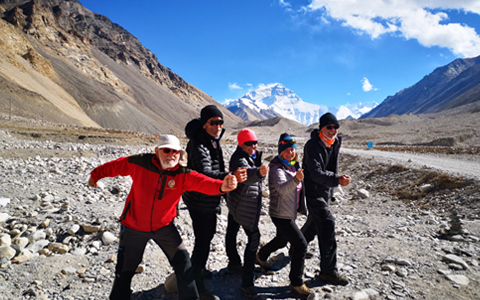Nepal and Tibet are two lands that are often mistaken for each other, mainly due to their close proximity. And while there are many things about the two places that are similar, there are also many things that are different about them. Aside from the fact that they share the responsibility for the world’s highest mountain, Mount Everest, which lies exactly on the border between Tibet and Nepal, there are many things that they have in common in terms of religion and culture.
 Nepal and Tibet have in common in terms of religion and culture.
Nepal and Tibet have in common in terms of religion and culture.Religion
Both cultures have had heavy influence on each other, and Buddhism is just one of the things that they share. Both countries have Buddhist members in their population, although where majority of Tibet is Buddhist, only around 11 percent of Nepalese people follow the Buddhist faith. While majority of the Nepalese people are Hindus, there are many Buddhist monasteries, temples and stupas in the country, and Lumbini, in Nepal, was the birthplace of Buddha. Moreover, despite the people being labeled as “Buddhist” or “Hindu”, majority of the people actually practice a symbiotic blend of Buddhism, Hinduism, and other shamanist or animist traditions.
 Buddhism is just one of the things that they share.
Buddhism is just one of the things that they share.Buddhist traditions in Nepal go back over 2,000 years, and have grown alongside the Hindu traditions that were adopted from India at around the same time as Buddhism increased in Asia. Majority of the Buddhists in Nepal follow the Nyingma school of Tibetan Buddhism, which has had a huge influence on the Buddhist traditions in Nepal, as have some of the traditions of Hindu Kashmir Shaivism.
Festivals
Despite many similarities between the two cultures, the festivals held around the year are very different. Many of the Tibetan festivals are centered around the Buddhist religion, such as Saga Dawa, the various Thangka festivals, and the popular Ongkor festival. Conversely, most of the Nepali festivals have their roots in Hinduism, since majority of the nation is Hindu. With Buddhism being the secondary religion of Nepal, very few Buddhist festivals from Tibet have been continued in the Buddhist population of Nepal, and the main one that is celebrated across the country is the Buddha Purnima, the Birth of Buddha.
.jpg) Saga Dawa Festival
Saga Dawa FestivalLikewise, the New Year celebrations are also different. The Tibetan New Year, Losar, occurs on the first new moon of their first month of the Tibetan Calendar, which is usually in February. In Nepal, the New Year celebration in the Nepal Sambat, the lunar calendar, occurs in November of the Gregorian calendar. The calendar systems are also different in many ways. In Tibet, the calendar follows the traditional lunisolar calendar, which is composed of twelve months, within twelve years named after animals, that occur in five cycles named after the mystical elements. In Nepal, the calendar is based on the Saka era Hindu calendar, which consists of twelve lunar months of either 29 or 30 days depending on the movement of the moon, and adds an extra month every third year to make up for the loss.
Dance and Music
Nepalese dancing and music is very unique, and very ancient. With the number of ethnic minorities across the country, the dances change a little from region to region, in both style and costumes, but mainly include many intricate movements of arms and hands, and delicate footwork. Many of the musical shows have set themes that tend to revolve around topics such as the harvest, marriage rites, love stories, and many stories of everyday life. In stark contrast, Tibetan dances and folk opera are based around the religion. The opera, known as Ache Lhamo, is a combination of dances, chants, and songs, and is drawn from the huge repertoire of Tibetan history and Buddhist stories.
 Unique and Ancient Nepalese Dancing
Unique and Ancient Nepalese DancingMany of the instruments used in both Nepal and Tibet bear striking similarities, although the music can be both different and similar, depending on the theme and the occasion. The main difference in the music of Tibet is that it is based in religion. Most Tibetan music is religious, and reflects the profound Buddhism that is inherent within the culture. Chanting is also a major part of both music and dance, and most Tibetan music involves chanting in either Tibetan or Sanskrit as an integral part of the religious practice.
Influences
Over the centuries, Tibetan culture has developed after the influence of many external as well as internal factors. Neighboring countries have played a major part in the development of Tibetan culture, including India, Nepal, and Bhutan, as well as China and Mongolia. The introduction of Buddhism in the 8th century was the main factor in Tibetan culture, and has become so inextricable interweaved in their culture that it is now a part of their everyday lives.
 Most of Nepalese put Buddhist in their beliefs.
Most of Nepalese put Buddhist in their beliefs.Culture and customs in Nepal are also influenced by external factors, with majority of it having come from India. Hinduism runs through many of the customs of the Nepali people, such that they do not eat beef and no female animal is ever killed for food. However, the influences of the Indian subcontinent rarely reached the mountain peoples of Nepal, and many are either Buddhist, shamanist, or animist in their beliefs.
Families
Family customs in Nepal are centered around the family unit, which takes precedence over the individual. The elderly are cared for and respected, and traditional households are large, often including the extended family of aunts and uncles, as well as other relatives living in the same house. Marriage customs can vary between the different castes in Nepal, although traditional arranged marriages are still very common. Many of the young people of Nepal still support arranged marriages, allowing their parents to choose their spouse for them. The caste system is still very prevalent in Nepal, and marriages must be within the same caste, religion and creed. Moreover, once the couple are married, the bride becomes the property of the husband, and is not permitted to return home, except for family visits, even if she is mistreated.
 Traditional arranged marriages are still very common.
Traditional arranged marriages are still very common.This was also true in Tibet, where often the bride-to-be only knew of the arrangement of the marriage a few days before, although for some this is changing with the introduction of modern, westernized ways. Traditionally, the bride is betrothed to her future husband through a parental arrangement, which is often more in favor of the husband’s family than the wife’s. However, that is where the traditions and customs end. Marriages that are arranged usually occur when the bride is still in her early teens, and then she returns to the home of her parents until she reaches puberty. Marriage in Tibet has three distinct sides to it, although there are also other permutations of these that can make the whole situation extremely complex. While some are monogamous, particularly in the Amdo region, many marriages in Tibet over the centuries have practiced polyandry (where there is one wife who is married by two or more husbands, usually brothers) and polygamy (which has one husband and two or more wives), although polygamy is normally restricted to the rich and the nobility.
Common Taboos
Nepal
1. Affection between men and women, even married, is selfdom expressed. Public kissing, hugging, and hand- holding are offensive to most Nepalese and considered immoral. However, it is acceptable for two men to walk hand in hand.
2. Clothing is conservative. Men should not go bare- chest and shorts should be conservative. Women should avoid bare shoulders halter tops, and shorts. Ties and suits are not necessary except for special occasions.
3. Cows are sacred. They go and sleep where they want. Watch out for them if you must stretch out while sitting on the floor.
4. Heads are sacred and should be treated with respect at all times, and never shown disrespect. Never take a topi (hat) off a man's head, even in fun.
5. Baksheesh is an extra payment for a service performed and is usually given to porters or laborers at the end of the job, much like a tip. It can be money, clothes or anything else and there is no set rate.
6. Bargaining is to be expected. Do not bargain if you are not really interested in the item. If your price is accepted, do not try to back out, and never try to get an even lower price.
7. Jutho (impurity) refers to food that is ritually polluted and therefore inedible. Any food which has come into contact, either directly or indirectly, with the month becomes jutho.
8. Left hands are used for cleaning oneself after going to the toilet. It is never used to pass or accept things, whether food at the table or money with a shopkeeper.
Tibet
1. Presenting a Hada (a white woven scarf which symbolizes purity and loyalty) is a traditional practice in Tibet to show respect and hospitality. One should never refuse the hada.
2. When Tibetans greet each other, they use long words. They often add 'la' after the name to show their respect. While everybody is being greeted, the listener must listen carefully without any impatience.
3. Sky burials are sacred, and are not permitted to be seen by outsiders. Do not try to intrude on a sky burial, or take photographs, even from a distance.
4. Public shows of affection are another taboo in Tibet. People rarely ever even hold hands in public, and never kiss.
5. Pointing the feet at someone or at a religious artifact when sitting is considered rude, so tuck your feet up so they are not facing anything except the floor. And do not stretch out yours legs when sitting, as it is rude to make people step over them.
As the old going says, seeing in believing. Why not join our Tibet and Nepal tours to experience the exotic customs by yourself?

























 Nepal and Tibet have in common in terms of religion and culture.
Nepal and Tibet have in common in terms of religion and culture. Buddhism is just one of the things that they share.
Buddhism is just one of the things that they share..jpg) Saga Dawa Festival
Saga Dawa Festival Unique and Ancient Nepalese Dancing
Unique and Ancient Nepalese Dancing Most of Nepalese put Buddhist in their beliefs.
Most of Nepalese put Buddhist in their beliefs. Traditional arranged marriages are still very common.
Traditional arranged marriages are still very common.







Ask a Quick Question